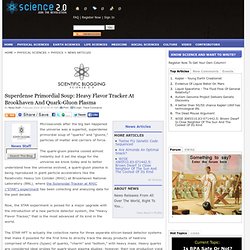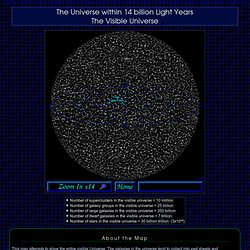

Superdense Primordial Soup: Heavy Flavor Tracker At Brookhaven And Quark-Gluon Plasma. Microseconds after the big ban happened the universe was a superhot, superdense primordial soup of “quarks” and “gluons,” particles of matter and carriers of force.

The quark-gluon plasma cooled almost instantly but it set the stage for the universe we know today and to better understand how the universe evolved, a quark-gluon plasma is being reproduced in giant particle accelerators like the Relativistic Heavy Ion Collider (RHIC) at Brookhaven National Laboratory (BNL), where the Solenoidal Tracker at RHIC ("STAR") experiment has been collecting and analyzing data for the past decade. Now, the STAR experiment is poised for a major upgrade with the introduction of a new particle detector system, the “Heavy Flavor Tracker,” that is the most advanced of its kind in the world. The Heavy Flavor Tracker is actually three detectors, a double-sided silicon strip detector (SSD), an intermediate silicon tracker (IST), and a pixel detector (PXL). Heavy Flavor Tracker boosts physics work at STAR experiment.
The Heavy Flavor Tracker is the newest member of the STAR detector family at the Relativistic Heavy Ion Collider (RHIC).
The addition of the HFT will be a boost for studies of the quark-gluon plasma. Image: Brookhaven National LaboratoryIn the first few microseconds after the Big Bang, the universe was a superhot, superdense primordial soup of quarks and gluons, particles of matter and carriers of force respectively. This quark-gluon plasma cooled almost instantly, but its brief existence set the stage for the universe we know today. To better understand how our universe evolved, scientists are re-creating a quark-gluon plasma in giant particle accelerators such as the Relativistic Heavy Ion Collider (RHIC) at Brookhaven National Laboratory (BNL), where an elaborate experiment called “STAR,” for Solenoidal Tracker at RHIC, has been collecting and analyzing data for the past decade.
Scientists and engineers at the U.S. Source: Lawrence Berkeley National Laboratory. Multiverse. Parallel Universes: Are They More Than a Figment of Our Imagination? A Galaxy Classic. "The multiverse is no longer a model, it is a consequence of our models.”

~Aurelien Barrau, particle physicist at CERN The Hollywood blockbuster, The Golden Compass, adapted from the first volume of Pullman's classic sci-fi trilogy, "His Dark Materials" portrays various universes as only one reality among many, but how realistic is this kind of classic sci-fi plot? While it hasn’t been proven yet, many highly respected and credible scientists are now saying there’s reason to believe that parallel dimensions could very well be more than figments of our imaginations. "The idea of multiple universes is more than a fantastic invention—it appears naturally within several scientific theories, and deserves to be taken seriously," stated Aurelien Barrau, a French particle physicist at the European Organization for Nuclear Research (CERN).
According to quantum mechanics, nothing at the subatomic scale can really be said to exist until it is observed. The work has another strange implication. The Universe within 14 billion Light Years - The Visible Universe. About the Map This map attempts to show the entire visible Universe.

The galaxies in the universe tend to collect into vast sheets and superclusters of galaxies surrounding large voids giving the universe a cellular appearance. Because light in the universe only travels at a fixed speed, we see objects at the edge of the universe when it was very young up to 14 billion years ago. The Size of the Universe The visible universe appears to have a radius of 14 billion light years because the universe is about 14 billion years old.
The Scale of Things.
Dim Matter.